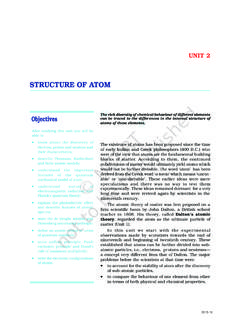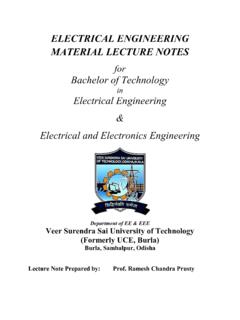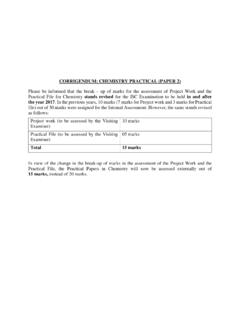Transcription of UNIT G485 Module 4 X-Rays - St Ambrose College
1 unit G485 Module 4 X-Rays Candidates should be able to : Describe the nature of X-Rays . Describe in simple terms how X-Rays are produced. Describe how X-Rays interact with matter (limited to photoelectric effect , Compton effect and pair production). Define intensity as power per unit cross-sectional area. Select and use the equation to show how the intensity, I of a collimated X-ray beam varies with thickness, x of the medium. Describe the use of X-Rays in imaging internal body structures, including the use of image intensifiers and of contrast media.
2 Explain how soft tissues, like the intestines, can be imaged using barium meal. Describe the operation of a computerised axial topography (CAT) scanner. Describe the advantages of a CAT scan compared with an X-ray image. X-Rays were discovered by Wilhelm R ntgen in 1865, when he found that a fluorescent plate glowed when it was placed close to a discharge tube. He saw an image of the bones in his hand when he placed it between the tube and the plate and deduced that some sort radiation was being emitted from the discharge tube. In 1906, Charles Barkla showed that X-Rays can be polarised and so proved that they were transverse waves.
3 Six years later, Arnold Sommerfeld estimated the wavelength of X-Rays . By using the regular array of atoms in a crystal as a diffraction grating, Max Von Laue was able to observe an X-ray diffraction pattern from which the wavelength was calculated. FXA 2008 I = I0e- x 1 HISTORY NATURE OF X-Rays X-Rays are electromagnetic waves (or photons of radiation) of wavelength 10-8 to 10-13 m, which places them between ultraviolet and gamma- rays in the electromagnetic spectrum. unit G485 Module 4 X-Rays X-Rays are produced when fast-moving (high energy) electrons are rapidly decelerated as a result of striking a heavy-metal target ( tungsten).
4 The diagram opposite shows a modern X-ray tube. A very high voltage ( 100kV) is placed across electrodes in an evacuated tube. Electrons are produced at the negative electrode (cathode), which is heated by an electric current passing through a filament. These electrons are then accelerated by the between the cathode and the positive electrode (anode) which is the rotating tungsten target. Most of the kinetic energy of the electrons is transferred to thermal energy of the target, but about 1% is converted into X-Rays . The target gets very hot and has to be cooled by circulating oil or water through it.
5 The tube is evacuated so as to minimise energy loss of the accelerated electrons by collision with gas molecules. The greater the accelerating voltage, the greater is the energy of the X-Rays produced. Since the energy of a photon (E) is related to the frequency (f) by the equation E = hf (where h = Planck s constant = x 10-34 Js), FXA 2008 PRODUCTION OF X-Rays cathode As ENERGY (E) increases, the X-ray FREQUENCY (f) increases and the WAVELENGTH ( ) decreases. Consider an electron having a charge (e) being accelerated through a (V) and striking a metal target to produce X-Rays having a maximum frequency (fmax).
6 Maximum energy of X-ray photon = work done by the accelerating hfmax = eV In terms of wavelength ( ) : hc = eV min (C) (V) fmax = eV h (Hz) (Js) (m s-1) hc = eV min (m) 2 unit G485 Module 4 X-Rays The X-ray photons are produced by two different processes : Characteristic X-Rays These X-ray photons have definite energies and they are produced when a bombarding electron knocks an inner-shell electron out of a tungsten atom and this causes electron transitions to fill the vacancy.
7 Bremsstrahlung (braking radiation) X-Rays These X-ray photons have a continuous range of energies. They are produced as a result of the deflection (and so deceleration) of bombarding electrons by the electric field around the nuclei of the target atoms. An accelerating charged particle emits energy. The diagram opposite shows the output spectrum from a typical X-ray tube for one value of accelerating voltage. The peaks correspond to characteristic X-Rays and the continuous curve to bremsstrahlung X-Rays .
8 PRACTICE QUESTIONS (1) 3 DATA : Planck constant, h = x 10-34 Js. Speed of radiation in vacuo, c = x 108 m s-1. Electron charge, e = x 10-19 C. 1 Calculate the maximum frequency and minimum wavelength for X-Rays produced from an X-ray tube in which the accelerating voltage is : (a) 80 kV, (b) 120 kV. 2 An X-ray tube is set at an accelerating potential difference of 100 kV. If the tube is % efficient and the current through it is 30 mA, calculate : (a) The electrical power supplied to the tube.
9 (b) The power of the X-ray beam it produces. (c) The minimum wavelength of the X-Rays produced. 3 An X-ray tube is working at an accelerating voltage of 240 kV and the current through it is 25 mA. The target is a block of heavy metal having a mass of kg, specific heat capacity of 300 J kg-1 K-1 and a melting point of 3000 K. If the target temperature is 300 K when the tube is first switched on, and the cooling system fails, calculate the target temperature after the tube has been running for 3 minutes.
10 Assume that all the electrical energy supplied is transferred to thermal energy of the target. FXA 2008 unit G485 Module 4 X-Rays X-Rays may be regarded as either waves or particles (photons). The intensity of an X-ray beam is reduced (attenuated) as it passes through matter. This happens as a result of absorption or scattering of the X-ray photons. There are three main attenuation mechanisms : In this case, the incident X-ray photon ejects one of the orbital electrons from an atom of the absorbing material, Giving its energy to the electron. An electron from a higher energy level may drop to fill the vacancy, with the subsequent emission of a characteristic X-ray photon.








